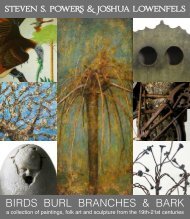SHUT THE DOOR AND LISTEN FROM OUTSIDE
In conjunction with the Outsider Art Fair: New York, we present our Winter 2020 Catalogue, "Shut The Door And Listen From Outside" This 88-page catalog features recent finds in the genres of Outsider and Self-Taught Art with a few additions of related American Folk Art. (Please note that NOT all of these works will be exhibited at The Outsider Art Fair). "Shut The Door And Listen From Outside" is a statement from Oblique Strategies, which is a set of cards each with a suggestion, directive, or constraint created by the artists Brian Eno and Peter Schmidt to encourage lateral thinking and to break creative blocks. With this in mind, as an art dealer or collector, one may think, how will this look if I see it indirectly? From a room away? Through a window? Obscured through a crowd of people? Or as I quickly scroll through Instagram? This question is not a shallow proposition—we often see a particular artwork from an off-angle or perspective—not in optimal presentation. Indeed, if we think about it, we likely first approached an artwork we came to love because it looked good "from outside." It had something special going on from a small section we gleaned through a crowd of people, or the composition came into focus as we came towards it from another room. As an artist, we may interpret this as another way of seeing. To purposely not see clearly or overtly—to create something anew based on partial information or hazy suggestions seen or heard. Or another way to look at a work in progress. View it from the side, across the room, or without glasses to see a fuzzy tonal map—is it still working for you?
In conjunction with the Outsider Art Fair: New York, we present our Winter 2020 Catalogue, "Shut The Door And Listen From Outside" This 88-page catalog features recent finds in the genres of Outsider and Self-Taught Art with a few additions of related American Folk Art. (Please note that NOT all of these works will be exhibited at The Outsider Art Fair).
"Shut The Door And Listen From Outside" is a statement from Oblique Strategies, which is a set of cards each with a suggestion, directive, or constraint created by the artists Brian Eno and Peter Schmidt to encourage lateral thinking and to break creative blocks.
With this in mind, as an art dealer or collector, one may think, how will this look if I see it indirectly? From a room away? Through a window? Obscured through a crowd of people? Or as I quickly scroll through Instagram? This question is not a shallow proposition—we often see a particular artwork from an off-angle or perspective—not in optimal presentation. Indeed, if we think about it, we likely first approached an artwork we came to love because it looked good "from outside." It had something special going on from a small section we gleaned through a crowd of people, or the composition came into focus as we came towards it from another room.
As an artist, we may interpret this as another way of seeing. To purposely not see clearly or overtly—to create something anew based on partial information or hazy suggestions seen or heard. Or another way to look at a work in progress. View it from the side, across the room, or without glasses to see a fuzzy tonal map—is it still working for you?
- No tags were found...
You also want an ePaper? Increase the reach of your titles
YUMPU automatically turns print PDFs into web optimized ePapers that Google loves.
STEVEN S. POWERS<br />
WINTER 2020<br />
<strong>SHUT</strong> <strong>THE</strong> <strong>DOOR</strong> <strong>AND</strong><br />
<strong>LISTEN</strong> <strong>FROM</strong> <strong>OUTSIDE</strong>
STEVEN S. POWERS<br />
<strong>SHUT</strong> <strong>THE</strong> <strong>DOOR</strong> <strong>AND</strong> <strong>LISTEN</strong> <strong>FROM</strong> <strong>OUTSIDE</strong><br />
"Shut The Door And Listen From Outside" is a statement from Oblique<br />
Strategies, which is a set of cards each with a suggestion, directive, or<br />
constraint created by the artists Brian Eno and Peter Schmidt to encourage<br />
lateral thinking and to break creative blocks.<br />
With this in mind, as an art dealer or collector, one may think, how will this<br />
look if I see it indirectly? From a room away? Through a window? Obscured<br />
through a crowd of people? Or as I quickly scroll through Instagram? This<br />
question is not a shallow proposition—we often see a particular artwork from<br />
an off-angle or perspective—not in optimal presentation. Indeed, if we think<br />
about it, we likely first approached an artwork we came to love because it<br />
looked good "from outside." It had something special going on from a small<br />
section we gleaned through a crowd of people, or the composition came into<br />
focus as we came towards it from another room.<br />
As an artist, we may interpret this as another way of seeing. To purposely not<br />
see clearly or overtly—to create something anew based on partial information<br />
or hazy suggestions seen or heard. Or another way to look at a work in<br />
progress. View it from the side, across the room, or without glasses to see a<br />
fuzzy tonal map—does it still work for you?<br />
Our next fair is:<br />
The Outsider Art Fair: New York<br />
January 16-19, 2020<br />
Metropolitan Pavilion, 125 W 18th St, New York, NY 10011<br />
Show information: outsiderartfair.com<br />
W O R K S O F<br />
& americana<br />
A R T<br />
109 3rd Place #2, Brooklyn, NY 11231 | 718.625.1715 or 917.518.0809 | stevenspowers.com | member: ADA
Folk Art Bacchus on Barrel (detail)<br />
Northern France<br />
Circa: Mid 19thC<br />
Size: 7 1/2" (w) x 9 1/2" (h)
Dark Trees<br />
Emile Brancha<br />
Circa: 1930<br />
Size: 36" (h) x<br />
Provenance: G<br />
York collection<br />
Exhibited: Zab<br />
1962.
Emile Branchard: Revisited<br />
Room 521 in the expanded and rehung Museum of Modern Art is dedicated to<br />
past director, Alfred H. Barr, Jr., and his groundbreaking exhibit of 1938,<br />
"Masters of Popular Painting." The show focused on self-taught and artists<br />
removed from the mainstream market or as they were called then, "folk artists,<br />
or naives," today we may term them as "outsiders." Emile Branchard was one of<br />
the artists represented in that seminal exhibit.<br />
Branchard was born (1881) and raised on the streets of New York City and lived<br />
in a large rooming house that his mother ran on Washington Square South. At<br />
the age of thirty-seven, Emile Branchard, a former truck driver, longshoreman,<br />
and policeman, found himself with tuberculosis and was forced to retire. He set<br />
up a painting studio in the basement and created imagined landscapes. A border<br />
of the house who recognized Branchard's talent entered a few paintings, without<br />
his knowledge, to the Society of Independent Artists show of 1919. His works<br />
were accepted and influential gallerist, Stephen Bourgeois offered him a solo<br />
show later that same year (Bourgeois would then regularly exhibit his work until<br />
1932).<br />
Bourgeois remarked of Branchard's work at the Independent Show, "those two<br />
small paintings appeared as the best<br />
proof, that art is not a question of<br />
colouristic or formalistic ability or<br />
brush-acrobatics, but primarily a<br />
question of vision."<br />
rd (1881–1938)<br />
24" (w)<br />
raham Gallery; Zabriskie Gallery; Private New<br />
.<br />
riskie Gallery, ‘Emile Branchard,’ March/April<br />
The progressive art cognoscenti of the<br />
1920-30s advocated for artists on the<br />
margins—artists that didn't rely on<br />
painterly craft or apprenticeship to<br />
express what they saw and how they saw
it. Holger Cahill wrote, "They are devoted to fact, as a thing to be known and<br />
respected, not necessarily as a thing to be imitated. Surface realism means<br />
nothing to these artists." Branchard himself stated, "I've never seen the ocean<br />
or spent a day out of New York. All art is a dream."<br />
“[Branchard was] Born like a poet<br />
with a spontaneous gift.... Poets are<br />
born and not made in schools. I<br />
hope one day we will wake up to<br />
the fact, that the art of rhythmical<br />
painting is also a form of poetry<br />
and unteachable.”<br />
Branchard died in February<br />
of 1938, just months before<br />
the opening of the "Masters<br />
of Popular Painting"<br />
exhibit. In addition to the<br />
five works hung at MOMA,<br />
The Marie Harriman<br />
Gallery held a memorial<br />
exhibition later the same<br />
year.<br />
The noted art dealer Sidney<br />
Janus included Branchard<br />
—Stephen Bourgeois, 1932.<br />
in his 1942 book, "They<br />
Taught Themselves." Janus<br />
recalls that when Branchard<br />
wanted to paint, he would set up a canvas and while doing house chores, he<br />
would pass the easel several times throughout the day—glancing at the blank<br />
canvas and then "all at once [see] a picture upon it, and put it down in paint."<br />
In addition to Janus, other New York galleries such as Graham Gallery and the<br />
then young [Virginia] Zabriskie Gallery carried the torch for Branchard and<br />
continued to exhibit his work in the 50s-70s. Additionally, the art dealer and<br />
folk art advocate [Robert] Schoelkopf Gallery showed his work.
Through The Pines<br />
Emile Branchard (1881–1938)<br />
Circa: 1919<br />
Size: 12 1/2" (h) x 16" (w)<br />
Provenance: Bourgeois Galleries; Rabin & Krueger Gallery;<br />
Private New York collection.<br />
Exhibited: Bourgeois Galleries, ‘Emile Branchard,’<br />
October/November 1919.
Branchard's work is held in several major museum collections including,<br />
MOMA, The Met, The Hirshhorn, The Philadelphia Museum of Art,<br />
Museum of Fine Arts Boston, and the Albright-Knox Museum.<br />
Selected Bibliography:<br />
Harriman Marie, Memorial Exhibition, Emile Branchard. New York: Marie<br />
Harriman Gallery, 1938.<br />
Zabriskie, Virginia, Emile Branchard : March 26th through April 14th 1962.<br />
New York: Zabriskie Gallery, 1962.<br />
Bourgeois, Stephen, Exhibition of Painting and Drawings by Emile Branchard.<br />
New York: Bourgeois Galleries, 1919.<br />
Janus, Sidney, They Taught Themselves : American Primitive Painters of the<br />
20th century. New York: The Dial Press, 1942.<br />
Cahill, Gauthier, Cassou, & Miller, Masters of Popular Painting, Modern<br />
Primitives of Europe and America. New York: The Museum of Modern Art,<br />
1938.<br />
Hemphill and Weissman, Twentieth-century American folk art and artists.<br />
New York: E.P. Dutton, 1974.
Small Landscape<br />
Emile Branchard (1881–1938)<br />
Circa: 1920<br />
Size: 5 1/2" (h) x 6 1/4" (w)<br />
Provenance: Zabriskie Gallery; Private<br />
New York collection.
Moulton Mill<br />
George E. Morgan (1870-1969)<br />
Oil on canvas board<br />
Circa: 1963<br />
Size: 20 (h)" x 16" (w)<br />
Provenance: Anne K. Wardwell; Mr. & Mrs. Sumner and Helen<br />
Johnston; Joe Wetherell; Raymond Saroff and Howard Rose; Peter Brams<br />
One of Morgan’s larger works, this is an imagined arial view above<br />
Moulton’s Mill, which was originally built in 1790 as Adams Mill and<br />
located on Branch Brook, which gets its water from Rock Haven Lake, in<br />
Newfield, Maine<br />
Exhibitions: The Playhouse, Boothbay, ME 1963; Farnsworth Art<br />
Museum, Rockland, ME, July 16 - October 11, 1998; The Center for<br />
Intuitive and Outsider Art, Chicago, IL, February 5 - April 10,1999<br />
Literature: UNEXPECTED ELOQUENCE, The<br />
Edith Blum Art Institute, Bard College,<br />
Annandale-on-Hudson, 1990, by Howard Rose<br />
“George E. Morgan; Self Taught Maine Artist,”<br />
FOLK ART MAGAZINE, Summer 1998, p. 30,<br />
Chippy Irvine.
Ice Houses<br />
George Morgan (1870-1969)<br />
Dated: January 1963<br />
Oil on canvas board<br />
Size: 16" (h) x 20" (w)<br />
Provenance: Anne K. Wardwell, Farmingdale, ME; Mr. & Mrs. Sumner and<br />
Helen Johnston, CT; Joe Wetherell, North Salem, NY; Raymond Saroff and<br />
Howard Rose, New York, NY; Peter Brams, Jackson Heights, NY<br />
From the 1820s to the end of the century, the Kennebec River was part of a<br />
flourishing ice trade. In the winters, ice from the river was cut into blocks,<br />
packed in sawdust, stored in warehouses, and shipped all over the world (as<br />
far as India).<br />
Because of its purity, ice from the Kennebec was known worldwide as<br />
“Kennebec Diamonds.”<br />
Exhibitions: The Playhouse,<br />
Boothbay, ME 1963Farnsworth Art<br />
Museum, Rockland, ME, “George E.<br />
Morgan: Self Taught Painter of<br />
Maine” July 16 - October 11, 1998;<br />
The Center for Intuitive and<br />
Outsider Art, Chicago, IL, “George<br />
E. Morgan: Maine Streets” February<br />
5 - April 10, 1999.<br />
Illustrated and discussed in:<br />
UNEXPECTED ELOQUENCE, 1990.<br />
Early postcard illustrating the Randolph Ice House & Mill.
Memory Painting of Kiva<br />
Anonymous<br />
Oil on plywood with taped labels<br />
Circa: 1950-1960s<br />
Size: 35" (w) x 18" (h)<br />
A massive wave of Latvian immigrants came to the United States after<br />
World War II. Having Suffered through Soviet and Nazi occupations,<br />
hundreds of thousands fled and spent years in European refugee camps<br />
before some of them immigrated to the United States in the early 1950s.<br />
The work calls to mind the paintings of George Morgan, who composed<br />
memory paintings from a bird's-eye's perspective. Intuitively we use this<br />
aerial device as a method of recall.
The Disobidient Prophet<br />
Signed, “Inez’<br />
Oil on canvas board<br />
Circa: 1950s-1960<br />
Size: 16" (h) x 20" (w) (sight)<br />
A label on the back reads, “Painted by the late - INEZ<br />
- a former patient in Memoroal Hospital.<br />
Purchased from her for $50.00.<br />
—Mrs. B.L.S. November, 1961.”<br />
Unfortunately we have not identified “Inez” or, “Mrs.<br />
B.L.S.,” but objectively the naive painting is quite<br />
good (we agree with Mrs. B.L.S.’s commitment).<br />
I Kings 13:20-25 reads, “When the man of God had finished eating<br />
and drinking, the prophet who had brought him back saddled his<br />
donkey for him. As he went on his way, a lion met him on the road<br />
and killed him, and his body was left lying on the road, with both<br />
the donkey and the lion standing beside it.”
The Crucifixion<br />
Lucia Wilcox (1902-1974)<br />
Ink and watercolor on paper<br />
Circa: 1972/73<br />
Size: 14 1/2" (h) x 8 1/2" (w) (sight)<br />
Provenance: Private New York Collection.<br />
Lucia Wilcox painted this shortly after becoming blind from a tumor<br />
pressing on her optic nerve.<br />
An immigrant from Lebanon she moved to New York in 1938 and<br />
settled in Amagansett in 1942 and was very close friends with Lee<br />
Krasner, Jackson Pollock and Willem De Kooning.<br />
Though Lucia (as she was simply known) struggled to gain traction<br />
with her earlier work—her “blind” work found an audinece.<br />
On painting blind she said, “I see better than anybody. I have<br />
eliminated all the details. My mind is free of static. I don't have any<br />
distractions.”<br />
In 1974, shortly before her death, Lucia had a solo exhibition of her<br />
“galaxy” paintings at the Leo Castelli Gallery.
Variations of the Cross<br />
Mrs. George Dunham<br />
Black ink on paper<br />
Circa: 1940-1950<br />
Size: 8”(w) x 10 1/2” (h) (each)<br />
A collection of over one hundred variations of the<br />
cross painted by a midwestern wife of a pastor.<br />
Though the cross is now primarily associated with<br />
Christianity, it is an ancient symbol used by past<br />
cultures throughout time and the world over.<br />
Iconographically there are four basic variations:<br />
1) Crux quadrata (a cross of four equal arms);<br />
2) Crux immissa (with a long stem ratio);<br />
3) Crux commissa (based on the Greek letter tau or<br />
“T”); and<br />
4) Crux decussata (based on the Roman decussis or<br />
10, “X”).
"Perpitraight, Peerless, Perponderant"<br />
Melvin Way (1954-)<br />
Black ink on paper<br />
Circa: 2000<br />
Size: 5 1/2" (w) x 4" (h) (sight)<br />
The Outsider Artist Melvin Way suffers from schizophrenia,<br />
bi-polar disorder, and diabetes.<br />
Way has stated, “All my works have to go thru emissions, baptisms,<br />
and transmigrations before I release them into the stratosphere, I<br />
carry 500 drawings at a time in my raincoat, and they go thru rain<br />
sleet and snow, sometimes staying in my pocket for 6 months at a<br />
time.”<br />
Art critic Jerry Salz says of Way’s work, “[He is] a mystic visionary<br />
genius...one of the greatest living American artists. Melvin Way<br />
makes knotted diagrams of numbers, letters, lines, and arrows that<br />
look like alchemical equations.”
The Key To My Fantasy<br />
Pen & Ink on canvas board<br />
Circa: 1960-70<br />
Size: 16”(w) x 20” (h)<br />
This is a remarkable<br />
illustration by an as of yet<br />
unidentified artist. The<br />
adeptly rendered nude<br />
figure and intricate design<br />
are masterfully worked and<br />
executed.<br />
Atypically, the substrate is<br />
canvas board (not paper or<br />
bristol board). The artist<br />
must have used a steel pen<br />
versus a mechanical<br />
rapidograph-type pen as the<br />
tips would have broken<br />
over and over.
Folk Art Cane<br />
Wood, paint, glass, ball bearings.<br />
Circa: 1920-30<br />
Size: 36" (h)<br />
Provenance: American Primitive<br />
Gallery; Peter Brams Collection.<br />
Folk Art cane by a “known<br />
unknown” carver. A small group of<br />
carvings with stylistic similarities have<br />
been shown to be related and carved by<br />
the same hand. The most known of this<br />
group is a particularly strange monkey<br />
with an intense face. Several of these<br />
figures (including the aforementioned<br />
monkey) were donated to the American<br />
Folk Art Museum by Dorothea and Leo<br />
Rabkin, others have been found here<br />
and there. Likely Midwestern origin.<br />
What identifies carvings in this group<br />
are their overall facial features, glass<br />
eyes and unusual mouth treatment. The<br />
cane herein is very similar to the<br />
monkey.
Folk Art Carving of Big Foot<br />
Wood, wood stain, paint and glass.<br />
Circa: 1920-30<br />
Size: 24" (h) x 10 1/2" (w) x 6 1/2" (d)<br />
Sensational carving of a hairy<br />
humanoid ape-man or Big Foot-like<br />
figure.<br />
The hardwood body and head are<br />
carved from the solid while the jointed<br />
arms and hands are strung like a doll—<br />
the large feet are nailed on.
The Snake Handler<br />
Oil on canvas<br />
Circa: 1930<br />
Size: 39”(w) x 69” (h)<br />
Provenance: Larry Dumont Collection; Marna Anderson;<br />
Frederick Hughes; Chris Huntington Collection, 1974<br />
Large and engaging painting of an African-American woman<br />
wearing a grass skirt handling three snakes in tall grass.<br />
“Found in Bangor, Maine,” this sideshow or carnival banner<br />
was featured in the seminal 1974 Folk Art auction of the Mr.<br />
& Mrs. Christopher Huntington Collection.
Spirit Drawing<br />
Slate, chalk<br />
Circa: 1910-20<br />
Size: 6 1/4" (w) x 10" (h)<br />
Portrait of a man on slate with a message from<br />
beyond in red chalk. This is the very best preserved<br />
example of one of these slates that I have seen.<br />
Transcription below.<br />
“Dear Caran(?), Possessor of Earth Life, again I reach out from the<br />
Land of Souls to you my dear --- of earth, I bring to you the joy<br />
and comfort and health and peace of mind that you need in old<br />
age, but you are just ripening like the beautiful fruit -- and the<br />
orchard by and by gravitate to when you belong to the Shores of<br />
Eternal Bliss and happiness, be of good cheer for I will receive<br />
you into the summer C---- with upon --- and bid you welcome to<br />
our heaven (?) over him and to be again as our whole family<br />
never --- to part. For my love for you has grown in its purity and<br />
as a Husband and Father I pray aimed a --- for you all angels.<br />
Bless you, for I am always with you, Smith Stehl”
Wax Anatomical Model - Cross Section of a Head<br />
C. Kellner<br />
Wax, pigment<br />
Circa: 1910-20<br />
Size: 10 1/2" (w) x 11" (h)<br />
A well detailed anatomical model of a cross<br />
section of a human head further divided into<br />
longitudinal sections.
Cyanotype of a Cadaver<br />
Unique cyanotype photogram on paper<br />
Circa: 1930-1940<br />
Size: 13 1/2”(w) x 36” (h)<br />
Provenance: Gary Edwards Gallery.<br />
Though created for scientific purposes, this striking image of<br />
the male body with its stark composition and delicate tonal<br />
ranges of cyan has an unintentional air of reverence—a<br />
haunting witness mark—not unlike the Shroud of Turin or a<br />
Buddhist scroll.<br />
This work is part of a small group of cyanotypes by the same<br />
unknown photographer/physician. Others in the series are<br />
held in the collections of MOMA, The Metropolitan Museum,<br />
and The Museum of Fine Arts, Houston.<br />
Reference: Burns and Wilson, Cyanotypes: Photography’s Blue<br />
Period. Worcester Art Museum, 2016, pps.68-71
This small masterwork by Materson recalls a day when Materson as a young<br />
teenager skipped school and played strip poker with a couple of older girls. The<br />
event was exciting, but not in the way that he had imagined. His figure lay in the<br />
scene like Christ with outstretched arms and a loincloth (tighty-whities).<br />
From The American Visionary Art Museum, "Born March 15, 1954 in Milford,<br />
Connecticut, Raymond Materson grew up in the Midwest. He earned a G.E.D. and<br />
attended Thomas Jefferson College as a drama and philosophy major, but was<br />
plagued by a serious drug problem. To support his habit, he committed a string of<br />
robberies with a shoplifted toy gun, was eventually arrested and sentenced to 15<br />
years in a state penitentiary in Connecticut. To keep himself sane Ray taught<br />
himself to embroider, using unraveled socks for thread and a sewing needle<br />
secured from a prison guard. He stitched miniature tapestries depicting life<br />
outside prison walls and sold his works to other inmates for cigarettes. Most of<br />
Materson's miniature embroideries include approximately 1,200 stitches per<br />
square inch and measure less than 2.5 x 3 inches.<br />
Since his release from prison in 1995, Ray has worked as a teacher, counselor,<br />
caseworker, program director, design consultant and speaker. With the help of his<br />
former wife Melanie, he published his autobiography, "Sins and Needles: A Story<br />
of Spiritual Mending." In 2003, he became the first artist to ever receive the Robert<br />
Wood Johnson Foundation's Innovators Combating Substance Abuse Award.<br />
Materson's work has been featured in numerous exhibitions at The American<br />
Museum of Folk Art in New York City, The American Visionary Art Museum in<br />
Baltimore, MD, The Center for Contemporary Art in Seattle, WA, The Boston<br />
Metropolitan Museum of Art, and The New Museum of Contemporary Art in New<br />
York City to name just a few."<br />
Provenance: Peter Brams Collection.<br />
Illustrated & Discussed in: Sins & Needles, p.27
Public School Girls<br />
Ray Materson (1954 –)<br />
Unraveled socks<br />
Circa: 1994<br />
Size: 2 1/4" (h) x 2 3/4" (w) (sight)<br />
12" (h) x 14" (w) (framed)
Two Figures<br />
Frederick Hastings (1919-2013)<br />
Steel, air-dried clay, paint, lead and masking tape<br />
Circa: 1960-80<br />
Sizes: (left) 6 5/8" (h) / (right) 4" (h)<br />
The works of Frederick Hastings were discovered a few years ago, and much<br />
of the details of his life and work remains a mystery. These two figures are<br />
made from steel armatures, air dried clay, paint, and masking tape bikini<br />
bottoms.<br />
What is known is that he lived outside of Philadelphia, was an architect and<br />
may have had family money. It is also known that he was into trains and<br />
built elaborate sets.<br />
The figures are very well made, with steel armatures or skeletons and then<br />
carefully modeled with some air-dried clay or modeling putty. Most have<br />
applied paper bikinis, and several have wigs of cotton or wool. Most of the<br />
figures come with hand-made boxes, custom fit to accommodate the size<br />
and posture of each.<br />
At first glance, the figures appear hermaphroditic or trans-gendered.<br />
However, none have genitals—just muscular bodies with breasts. And<br />
though a significant effort is put into modeling and composing the figures,<br />
there appears to be no attempt to idealize or beautify the faces—which are<br />
often quite severe and grotesque.
Folk Art Fetish Figure<br />
Wood, wheat paste/sawdust glue<br />
composite, paint, pitch varnish<br />
Circa: 1900<br />
Size: 5 5/8" (h) x 1 1/2" (w)<br />
I regard this small figure as one of the<br />
most mysterious and striking figural<br />
carvings that I have ever seen.<br />
The body is carved from hardwood,<br />
and the rest of the female figure has<br />
applied composite features, including<br />
her face, breasts, belly button, and<br />
pubic area. The composite material<br />
appears to be made from a wheat paste<br />
mixed with glue and sawdust.<br />
The result of the applied facial “mask”<br />
looks like transplanted skin. The lips<br />
of her face and vagina have traces of<br />
applied dark red paint.<br />
The whole is finished with a natural<br />
tree pitch varnish.<br />
One can only speculate why this doll<br />
was carved. I have never seen a<br />
similar, but believe it to be more fetish<br />
in nature versus a simple play doll.
Induction Center<br />
Thomas King Baker (1911 - 1972)<br />
Watercolor, charcoal, and calendar scrap on craft paper<br />
Size: 13 1/4"(h) x 9" (w) (sight)<br />
Exhibited: Albrecht-Kemper Museum of Art, MO, 1997<br />
Illustrated and discussed in: Oh For Pity’s Sake, We’ve Already Seen This<br />
Opera: The Art of Thomas King Baker; p. 37<br />
Thomas King Baker was an insurance underwriter by day, self-taught,<br />
basement artist by night. He and his wife, Mila Hoover, were middleclass<br />
socialites and enjoyed the opera, galleries, museums and a vibrant<br />
nightlife. King was friendly with local artists and was a collector. Among<br />
friends and family, his art-making was a poorly kept secret—they knew<br />
of his passion but were unaware of the extent of King’s breadth and body<br />
of work. King never exhibited while he was alive.<br />
King died from the effects of alcoholism in 1972.<br />
In 1991, Thomas McCormick, an art dealer, stumbled upon a few<br />
interesting paintings that he could not immediately identify. After some<br />
detective work, McCormick figured out that the works were by Baker.<br />
McCormick contacted Baker’s wife Mila, who was still alive and<br />
cataloged a large cache of works that Mila had kept together.<br />
King’s paintings, illustrations, and sketchbooks were exhibited at the<br />
Albrecht-Kemper Museum in 1997.
In 2007, the bulk of King’s estate was donated to Intuit: The Center for<br />
Intuitive and Outsider Art in Chicago.<br />
The two works herein illustrate King’s use of scrap materials and his<br />
gifted use of line and color. Like one of the works herein, King<br />
produced several works with calendar fragments. King was not<br />
ignorant of art history and contemporary art and the use of block<br />
numbers on, “Induction Center,” is likely a nod to Jasper Johns.<br />
Edward, Edward<br />
Thomas King Baker (1911 - 1972)<br />
Oil on shirt cardboard on craft paper<br />
Size: 12" (h) x 9" (w) (sight)<br />
Exhibited: Albrecht-Kemper Museum of Art, MO, 1997<br />
Illustrated and discussed in: Oh For Pity’s Sake, We’ve Already Seen This<br />
Opera: The Art of Thomas King Baker; p. 58
Satan’s Strange Fruit<br />
Anonymous<br />
Graphite and crayon on paper<br />
Circa: 1960s<br />
Size: 11" (h) x 14" (w)<br />
A graphically strong anonymous drawing with<br />
demonic beasts and semi-mythological beings.
Study of a Male Nude &<br />
Young Highlander with<br />
Raised Arm<br />
John Kane (1860–1934)<br />
Circa: 1930<br />
Pencil on note paper<br />
Size: 8 1/2" x 5 1/2"<br />
Provenance: Galerie St.<br />
Etienne<br />
A rare John Kane double-sided pencil sketch. Kane is regarded as one of the masters of selfartists.<br />
On the above or recto, note how Kane makes room for the hands to complete the sketch—h<br />
while drawing the figure's arms, so he placed them to the lower left. Above the hands, Kane<br />
English painters that he must have been studying.<br />
The verso illustrates a young boy in a Highlander outfit (Kane would use this figure in a few<br />
The writing on this side lists the colors of the rainbow (Roy G. Biv).<br />
References: The Highland boy relates to figures in the following; Highland Hollow, Scotch D<br />
and Scotch Day, Kennywood (Arkus 68, 71 and 73).
taught American<br />
e ran out of room<br />
lists 18th-19thC<br />
finished paintings).<br />
ay at Kennywood<br />
verso
Circus Figure<br />
Elie Nadelman (1882-1946)<br />
Circa: 1938-46<br />
Size: 8 1/4” (height without base)<br />
Signed with initials EN on reverse; inscribed 'Inwood Pottery New<br />
York #4' on a label attached to reverse.<br />
Provenance: Zabriskie Gallery, New York, May 6, 1970;<br />
Private collection since.<br />
Exhibitions: Nadelman Memorial Exhibition, MOMA, 1948; 'Elie<br />
Nadelman, Sculptor of Modern Life,' Whitney Museum, 2003.<br />
Literature: Barbara Haskell, 'Elie Nadelman, Sculptor of Modern Life,'<br />
Whitney Museum, New York, 2003, p.190, fig. 212<br />
One of the more dynamic of the Nadelman plaster figures. The<br />
female circus figure with an outstretched right arm and her left on<br />
her hip (which creates a wonderful negative space).
Southern Folk Art Limestone Carving of a Kissing Couple<br />
Kentucky (found)<br />
Circa: 1930-40<br />
Size: 8” x 8” x 9” (h)<br />
A dynamic carving of a nude male and female embraced in a<br />
kiss with the man’s hand on her upper thigh. She is not<br />
resisting, but her slight push may be a signal to slow it down<br />
a bit.<br />
Carvings as such in limestone are quite rare in that this small<br />
sculpture packs a lot of life into the stone. The work is carved<br />
in-the-round, and the figures have remarkable tension<br />
between them.<br />
It was found in a river 65 years plus ago in Prestonsburg,<br />
Floyd County, Kentucky.
Bird Family<br />
James W. Washington, Jr. (1909-2000)<br />
Black granite, redwood burl<br />
Dated: 1973<br />
Size: 12 1/4" L x 8 1/8" D x 7 1/2" H<br />
Exhibited at: Bellevue Art Museum, Bellevue, WA, "The Spirit in the<br />
Stone: The Visionary Art of James W. Washington, Jr." March 10 - April<br />
16, 1989.<br />
Bird Family is a large work of a mother bird protecting and feeding three<br />
nestlings under her wing. The solid black granite metaphorically<br />
reinforces the strength of the matriarch, while Washington's sensitive<br />
carving conveys a certain intimacy and the fragility of life.<br />
James W. Washington, Jr. was an<br />
African-American, self-taught<br />
artist. Born in Gloster,<br />
Mississippi, Washington settled in<br />
Seattle as a government<br />
electricion. Washington’s spirited,<br />
but quiet carvings are seen as a<br />
cross between two other direct<br />
carvers; the African American Folk<br />
Artist William Edmondson (1874-<br />
1951) and American sculptor John<br />
Flannagan (1895-1942).
Man in Coffin<br />
James ‘Son Ford’ Thomas<br />
(1926-1993)<br />
Unfired clay, paint, wire<br />
Circa: 1980<br />
Size: 8 1/2" (l) x 4 1/2" (w)<br />
James ‘Son Ford’ Thomas<br />
was a self-taught artist and<br />
blues musician from<br />
Mississippi—to earn extra<br />
money he worked as a grave<br />
digger<br />
‘Son Ford’ Thomas’ work has<br />
been widely exhibited and<br />
collected and was featured in<br />
two seminal exhibits; Black<br />
Folk Art in America, 1930–<br />
1980, organized by the<br />
Corcoran Gallery of Art in<br />
Washington, DC., and<br />
Outliers and American<br />
Vanguard Art organized by<br />
the National Gallery of Art,<br />
2018.
Although Miroslav Tichý<br />
(1926-2011) was<br />
primarily known as a<br />
street photographer, he<br />
had a remarkable hand<br />
for drawing.<br />
During the 1970s Tichý began experimenting with monotype etchings. As with his<br />
tools for photography, his materials for engravings were improvised from recycled<br />
scraps of metal, plastic or wood.<br />
Tichý’s neighbor and come-biographer Roman Buxbaum, observed, “After<br />
scratching out the drawing he applied paint with the palm of his hand and then,<br />
applying pressure with a spoon, transferred it to paper.” The blurred lines and ink<br />
smears from this imperfect process resulted in etchings, not unlike his<br />
photographs, filled with a hazy and mysterious atmosphere.
Untitled [Woman Turned Right - Maroon]<br />
Miroslav Tichý (1926-2011)<br />
Monotype etching<br />
Circa: 1970s (n.d.)<br />
Size: 7 1/4" (w) x 13 1/2" (h)<br />
Untitled [Woman Turned Left - Indigo]<br />
Miroslav Tichý (1926-2011)<br />
Monotype etching<br />
Circa: 1970s (n.d.)<br />
Size: 5 3/4" (w) x 11 1/4" (h)
The Birds & The Bees<br />
Ange Boaretto (1920-??)<br />
France<br />
Circa: 1950s-60s<br />
Size: 43" x 8" (sight) / 48" x 12" (framed)<br />
Three large one piece, six paneled erotic<br />
paintings by self-taught artist Boaretto. Ange<br />
Boaretto was a master shoemaker in Southern<br />
France and self-taught painter.<br />
Although he had some recognition during his<br />
lifetime and a small exhibit at the Centre Georges<br />
Pompidou in 1979, entitled ‘Le Bible du Bottier’<br />
(The Boot-makers Bible), he has mostly been<br />
forgotten.
Alan Bricker<br />
Untitled (Green Man with Orange Hands)<br />
Acrylic on foamcore<br />
48” x 17 1/4”<br />
Circa: Mid-1990s<br />
Alan Bricker was an artist discovered by Tina Anton as part of the<br />
Art Program for the Homeless, a not for profit art exploration<br />
lasting 3 years in NYC.<br />
Bricker was brought to her attention by a caseworker in an East<br />
Village homeless shelter. Tina and her husband Aarne Anton<br />
(American Primitive Gallery) got excited by his paintings on scrap<br />
cardboard and found immediate response from collectors.<br />
Encouraged by the response Bricker took Tina and Aarne to his<br />
storage space to see more. The closet-like space was piled to the<br />
ceiling with scrap cardboard that had images and words painted<br />
on them. This space was a chaotic jumble akin to a rats nest, but<br />
each piece he pulled out was fantastic, each in a different way.<br />
Shortly after Bricker seemed to get unhinged and then<br />
disappeared. The Antons looked for him at the storage building,<br />
but was told that Bricker had stopped paying his rental and the<br />
contents were discarded.
Our Rug<br />
Pearl Blauvelt (1893-1987)<br />
Pennsylvania<br />
Graphite and colored pencil on notebook paper<br />
Circa: 1936<br />
Size: 10 3/8" (w) x 7 1/4" (h) (sight)<br />
Provenance: Kerry Schuss; Private Midwestern Collection.<br />
This small drawing illustrates a folk art hooked rug.<br />
A group of Blauvelt’s work is featured in the rehung MOMA,<br />
Room 521, The Alfred H. Barr Gallery.<br />
Blauvelt’s work is in several notable private and institutional<br />
collections including: Museum of Modern Art, New York;<br />
Museum of Everything, London; Pennslyvania Academy of the<br />
Fine Arts, Philadelphia.
L. C. Spooner<br />
Blue Mound, Illinois<br />
Red and black ink on paper<br />
Circa: 1936<br />
Size: 10 3/8" (w) x 7 1/4" (h) (sight)<br />
Provenance: American Primitive Gallery; Private New York<br />
Collection.<br />
Lee Cordova Spooner or “L. C.” as he signed his drawings was<br />
indeed an inventor of practical things (he held some patents),<br />
but he also aimed to create visionary machines based on<br />
self-propulsion, e.g. self-propelled motors, self-propelled trash<br />
cans, self-propelled scales, etc.<br />
Though these inspired concepts never materialized, Spooner<br />
left behind dozens of detailed mechanical drawings that often<br />
show multiple angles and variations of these extraordinary,<br />
but never realized contraptions.<br />
A large number of Spooner’s drawings are in the collection of<br />
the William Louis-Dreyfus Foundation.
Eddy Mumma (1908-1986)<br />
Oil on board in artist painted frame<br />
Circa: 1978<br />
Size: 22 1/2" (w) x 18 1/2" (h) (including frame)<br />
Provenance: Private New York Collection.<br />
In 1966, after the death of his wife, at the age of fifty-eight<br />
Mumma moved to Gainesville, Florida to be closer to his<br />
daughter. He suffered from diabetes and eventually lost both<br />
of his legs.<br />
During his lifetime Mumma refused to exhibit his work and<br />
after his death, his work was sold by his family.<br />
Mumma’s work is now in the collection of several major<br />
museums such as the Smithsonian American Art Museum;<br />
The American Visionary Art Museum; The American Folk Art<br />
Museum; & The Kohler Foundation.
Folk Art Bacchus on Barrel<br />
Northern France<br />
Circa: Mid 19thC<br />
Size: 7 1/2" (w) x 9 1/2" (h)<br />
A rare folk art ceramic<br />
sculpture of a grotesque<br />
magistrate atop a brandy<br />
keg.<br />
The earthernware figure has<br />
a manganese glaze with<br />
kaolin highlights to his facial<br />
features and hands.<br />
The CT Historical Society<br />
has a trade sign for the<br />
Bacchus Inn or Norwich,<br />
which features a man atop a<br />
keg. This highly stylized<br />
piece of folk art is a varient<br />
of the Dutch ‘Bobbejakken.’<br />
Literature: A related example<br />
is pictured in, Poteries et<br />
céramiques anciennes du<br />
Cotentin by Leberruyer<br />
Pierre, Lepoitevin Lucien, p.<br />
168, plate 99.
A Group of Fine Gogottes (offered individually)<br />
Fontainbleu France<br />
Oligocene epoch (33.9 million to 23 million years old)<br />
Size: 22" (l) / 9 1/2" (h) / 9" (h) / 13" (h)
A gogotte is a millions years old naturally shaped mineral concretion formed of tiny<br />
quartz fragments held together by calcium carbonate. Principally found in<br />
Fontainebleau, France, these mother-nature made sculptures have inspired artists from<br />
Jean Arp, Henry Moore and Louise Bourgeois. Louis XIV favored them and the have been<br />
exhibited at Versailles since the late 17thC.
Wavy Stripe Painted Southern Blanket Chest<br />
Virginia (found)<br />
Circa: 1850-70<br />
Size: 34 3/4” (w) x 18 1/2” (d) x 24” (h)<br />
A fantastic and lively Southern blanket chest (Virginia). Six board chest of<br />
deep proportions. Made from southern pine with applied moldings and<br />
conical feet. Wavy green and yellow stain all around (except backside). It has<br />
been suggested that this may be African American made/painted.
Folk Art Carved Sign Language Hands<br />
Circa: 1920<br />
Size: each hand measures ~1"(w) x 2” (h)<br />
A complete set of individually carved hands each<br />
carved to represent a letter in the American Sign<br />
Language (ALS) alphabet. The set has a small<br />
carved wooden card that reads, “1920, By Willie.”<br />
The other side of the card is carved with two hands<br />
shaped in sign language characters representing,<br />
“T C”
Snake Den<br />
Wood burl<br />
Circa: 1900-1920<br />
Size: 16" (l) x 11 1/4" (h)<br />
A wonderful twisty burl<br />
mass resembling a<br />
writhing snake den. One<br />
snake is carved from a<br />
branch growing through<br />
the burl mass, while<br />
others have nail eyes<br />
upon their suggestive<br />
heads.
Gas Station Beauty Queen<br />
Enamel paint on masonite<br />
Circa: 1960<br />
Size: 72" (h) x 24" (w)
Tunnel of Love<br />
Vintage glass tubing, neon gas, wood<br />
Circa: 1940-50s<br />
Size: 26 1/2" (h) x 19" (w) x 4" (d)<br />
Vintage neon sign from a carnival or theme park.<br />
The not-so-subtle female anatomical inner design<br />
has not been overlooked.
Willian (Bill) Anhang was born in Poland in 1931 and immigrated to<br />
Canada with his family in 1939 to escape the Nazi occupation. As a young<br />
man, Anhang trained as an engineer and worked in telecommunications. In<br />
1975, A Guru spoke to him and said he must become an artist. Since then<br />
Anhang’s has devoted himself to bring “new light to the planet.”<br />
The enamel works seen here are among Anhang’s earliest works. They are<br />
small-scale abstractions—many with suggestions of another world or grand<br />
universe. They have undeniable energy. Well composed, not too busy and<br />
with intense, saturated color.<br />
Anhang later incorporated real light into his work—paintings illuminated by<br />
hundreds if not thousands of blinking and programmed LEDs and fiber<br />
optics.<br />
These early enamel works may be seen<br />
as his acoustic period, like Dylan<br />
before Newport, and then he plugged<br />
in, went electric, and never really went<br />
back.<br />
Anhang’s work was recently exhibited<br />
at American Folk Art Museum in the<br />
exhibit, When the Curtain Never<br />
Comes Down, 2015.<br />
The Canadian Broadcasting<br />
Corporation (CBC) produced a 20<br />
minute documentary on Anhang,<br />
Billsville, and is available on Youtube.<br />
Photo of William (Bill) Anhang in his studio.
Untitled [Clipped Galaxy]<br />
William Anhang (1931-)<br />
Enamel on copper<br />
Circa: 1979<br />
Size: 7 3/8" (w) x 3 7/8" (h)<br />
Untitled [Green Trails]<br />
William Anhang (1931-)<br />
Enamel on copper<br />
Circa: 1979<br />
Size: 5 3/4" (w) x 3 7/8" (h)
STEVEN S. POWERS<br />
W O R K S O F<br />
A R T<br />
& americana<br />
109 3rd Place #2, Brooklyn, NY 11231 | 718.625.1715 or 917.518.0809<br />
stevenspowers.com | member: ADA


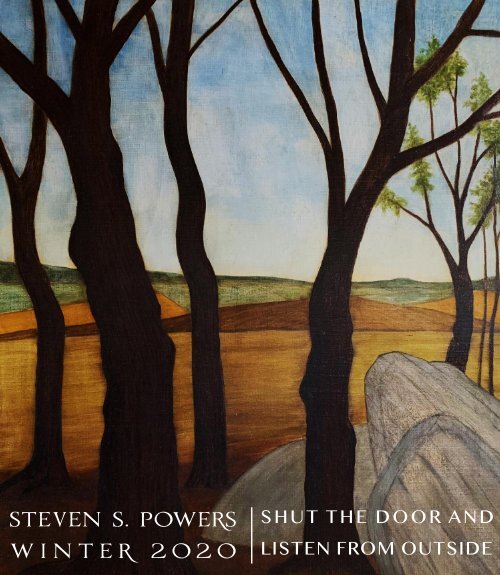

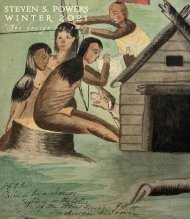
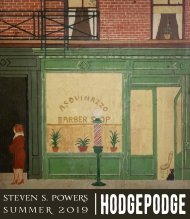
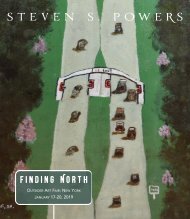

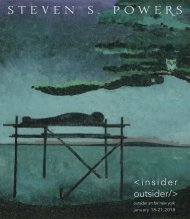
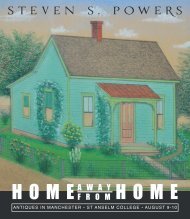
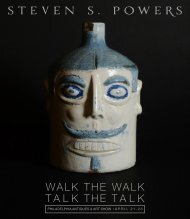
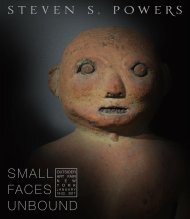
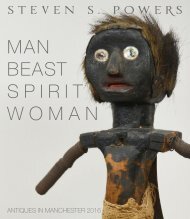
![NEEDLE • KNIFE • TORCH [&] BRUSH](https://img.yumpu.com/55309753/1/190x219/needle-o-knife-o-torch-brush.jpg?quality=85)
